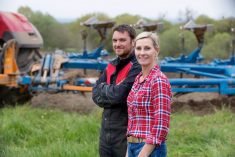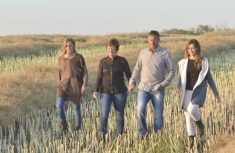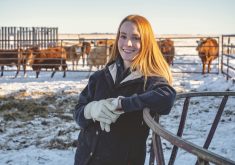Try it yourself. Check it out with women in agriculture who speak about gender issues in the industry. Find them informally via social media or look for them through an ag women’s organization, of which there are several across Canada today.
Then ask them what kind of response they get when they talk about gender equality in agriculture.
Here’s a big response they’ll report for sure. “What do you mean women are underrepresented in the industry, or that they’re inequitably paid? And what’s this talk about discrimination and sexism? That doesn’t exist anymore.”
Read Also

Farmland values: assumptions and realities
Where farmland values are headed and what decisions farmers should make
It’s feedback they hear all the time, and it comes not just from men, but women too.
So, who’s right?
Well, people who actually study the issue say that the old gender issues are still with us. There’s no way they’re a thing of the past. In fact, many women still face barriers to advancement and equal participation on the farm and throughout the broader ag industry.
“We have learned by observation and looking at data that agriculture is still a male-dominated environment,” says Laura Lazo, co-founder of MWAF (Manitoba Women in Agriculture and Food), a group that seeks to develop career and business opportunities to support and advance women, including those from underrepresented groups.
Gender issues exist, but that doesn’t mean we all recognize it. “Sometimes, the men and women who told me that men and women had equal opportunities and similar income, changed their minds when I present them the statistics,” Lazo says. “The disparity between gender income and job roles is present and real. All you have to do is to look at publicly available statistics to see that.”
Although at the post-secondary educational level the gender ratio is 50/50, and in some cases more, things change after graduation.
“When you go to conferences, trade shows and meetings, men are in the majority and there are fewer women in higher-level positions in the industry as well,” Lazo says. “It’s what we call the leaky pipeline — women fall out along their way up.”
- Read more: A Canadian woman’s experience in ag
That aligns with data from the Canadian Agricultural Human Resource Council (CAHRC) that shows over 90 per cent of women experience barriers to achieving management positions in the industry.
Meat business women
Across the pond in the United Kingdom, one segment of the ag industry has done the hard work of finding out exactly how many women work in the meat industry.
It turns out their work is documenting a pattern that occurs time and again in agriculture and on the farm, even in Canada.
Meat Business Women has commissioned an extensive research study providing a numerical and disturbing baseline. Globally, 36 per cent of people working in the meat industry are female, but at the board level that drops to 14 per cent. And at the CEO level, a mere five per cent are women.
Among unskilled workers in the industry, by contrast, 40 per cent are women.
Recognized by the UN, Meat Business Women started small in England six years ago, but has since grown into a global networking group for women working across the meat industry with local committees in the U.K., Ireland, Australia and New Zealand, and a growing number of individual and corporate members all across the world.
Critics who expect the group to be fiercely vegetarian will be disappointed. So will anyone expecting them to be revolutionaries of any other kind. Instead, the group’s vision is absolutely pro industry: “championing the meat industry as a great place to build a fulfilling lifelong career — where everyone can express their full potential.”
According to founder, Laura Ryan, who has worked in the meat sector for more than 20 years, Meat Business Women intends to help achieve that as a global, professional networking group for women working across the meat industry.
“Our mission is to inspire others to see the meat industry in a different light, to show the amazing roles that exist, and to be transparent about what the meat industry offers,” Ryan says.
Today, Meat Business Women has over 7,000 followers on LinkedIn and other social media channels, with members all along the supply chain including producers, processors, retailers and food service. More than 5,000 people have attended its events worldwide, with numbers increasing as it offers more virtual programs and events.
But still, it has a big challenge ahead of it.
Women stall on the corporate ladder
“The data clearly show that industries with more gender balance and diversity are more profitable,” Ryan says. “And for industries like ours that normally are running on wafer-thin margins, why wouldn’t you want that? As well, organizations with more balance make better business decisions, they’re more agile and have better governance.”
The case for both gender and ethnic cultural diversity in corporate leadership is strong. According to Diversity Wins: How inclusion matters prepared by McKinsey & Company in the U.K., diversity is good for profitability. It compared the gender diversity of the executive teams of companies that scored in the top 25 per cent for profitability against those in the bottom 25 per cent. Diverse companies, it found, were 25 per cent more likely to have above-average profitability in 2019. That’s up from 21 per cent in 2017 and 15 per cent in 2014.
There is also a linear correlation to greater representation and higher performance. The report says: “Companies with more than 30 per cent women executives were more likely to outperform companies where this percentage ranged from 10 to 30, and in turn these companies were more likely to outperform those with even fewer women executives, or none at all.”
But the fact remains, the meat industry can be a tough sell to women. Meat Business Women’s research discovered that many people still assume the sector is macho, physically demanding and a tough environment to work in.
Of female students in agricultural college, 55 per cent reported no or little knowledge of the sector when making career choices, and 37 per cent believed they would face barriers to success because of their gender.
Their preconceptions are in line with the reality. For women, the meat industry has a career ladder that is missing some crucial rungs.
If women don’t climb the ladder, it isn’t because they take time off for families, the research shows. Instead, it’s because these companies insist that their CEOs have strong operational backgrounds. But these companies don’t hire women for operational roles.
And because they don’t hire women for operational roles, they don’t put time and energy into looking at how operational jobs could be made a better fit for women.
“Women are filling roles in quality control, marketing, finance, research and development, and human resources, but those aren’t the roles that feed us to the top,” Ryan says. “It’s important we make operational roles attractive to female talent so we’ve got a chance at getting in the organic pipeline.”
Towards that aim, the group recently launched a campaign called “She Looks Like Me,” a series of videos that showcase women in different roles in the meat sector.
“The meat industry can be very faceless,” Ryan says. “Creating female role models, so women can see people who are like them, is so important.”
Where are Canada’s numbers?
Meanwhile, it’s tough get a handle on gender equity in Canadian agriculture because the statistics simply don’t exist. No one has a clear picture of the roles women play across all segments of the industry.
MariJo Patino, co-founder of MWAF, is an agricultural economist and currently runs a Winnipeg-based freelance research consultancy. Patino has spent a lot of time combing through all the data scattered through various research, reports and statistics on agriculture, and says there is little information in terms of the actual gender and pay ratios, or where there are gaps or challenges that need to be addressed.
“There are more than two million people working in the Canadian agricultural system, and we don’t know how many of those are women,” Patino says. “Are they doing the same things as their male counterparts, and are they being paid the same. If there is a wage gap, how much is it?”
There are no comprehensive answers, because of how the data is produced and compiled. MWAF is looking for funding so it can work with Statistics Canada and Agriculture and Agri-Food Canada to analyze occupational and income gender data in order to develop information resources that the industry can use to develop HR initiatives focused on attracting diversity.
















